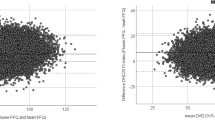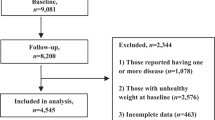Abstract
Background/objectives
Many diet quality scores exist, but fully food-based scores based on contemporary evidence are scarce. Our aim was to develop a food-based diet score based on international literature and examine its discriminative capacity and socio-demographic determinants.
Subjects/methods
Between 2006 and 2013, dietary intake of 129,369 participants of the Lifelines Cohort (42% male, 45 ± 13 years (range 18–93)) was assessed with a 110-item food frequency questionnaire. Based on the 2015 Dutch Dietary Guidelines and underlying literature, nine food groups with positive (vegetables, fruit, whole grain products, legumes&nuts, fish, oils&soft margarines, unsweetened dairy, coffee and tea) and three food groups with negative health effects (red&processed meat, butter&hard margarines and sugar-sweetened beverages) were identified. Per food group, the intake in grams per 1000 kcal was categorized into quintiles, awarded 0 to 4 points (negative groups scored inversely) and summed. Food groups with neutral, unknown or inconclusive evidence are described but not included.
Results
The Lifelines Diet Score (LLDS) discriminated well between high and low consumers of included food groups. This is illustrated by e.g. a 2-fold higher vegetable intake in the highest, compared to the lowest LLDS quintile. Differences were 5.5-fold for fruit, 3.5-fold for fish, 3-fold for dairy and 8-fold for sugar-sweetened beverages. The LLDS was higher in females and positively associated with age and educational level.
Conclusions
The LLDS is based on the latest international evidence for diet-disease relations at the food group level and has high capacity to discriminate people with widely different intakes. Together with the population-based quintile approach, this makes the LLDS a flexible, widely applicable tool for diet quality assessment.
This is a preview of subscription content, access via your institution
Access options
Subscribe to this journal
Receive 12 print issues and online access
$259.00 per year
only $21.58 per issue
Buy this article
- Purchase on Springer Link
- Instant access to full article PDF
Prices may be subject to local taxes which are calculated during checkout


Similar content being viewed by others
Change history
24 June 2019
An amendment to this paper has been published and can be accessed via a link at the top of the paper.
References
Kromhout D, Spaaij CJK, de Goede J, Weggemans RM. The 2015 Dutch food-based dietary guidelines. Eur J Clin Nutr. 2016;70:869–78.
Mozaffarian D, Ludwig DS. Dietary guidelines in the 21st century–a time for food. JAMA. 2010;304:681–2.
Jacobs DR, Tapsell LC. Food synergy: the key to a healthy diet. Proc Nutr Soc. 2013;72:200–6.
Food and Agriculture Organization of the United Nations. Background | Food-based dietary guidelines. http://www.fao.org/nutrition/education/food-dietary-guidelines/background/en/
Kennedy ET, Ohls J, Carlson S, Fleming K. The healthy eating index: design and applications. J Am Diet Assoc. 1995;95:1103–8.
Guenther PM, Casavale KO, Kirkpatrick SI, Reedy J, Hiza HAB, Kuczynski KJ, et al.Update of the healthy eating index: HEI-2010.J Acad Nutr Diet. 2013;113:1–20.
Trichopoulou A, Kouris-Blazos A, Wahlqvist ML, Gnardellis C, Lagiou P, Polychronopoulos E, et al. Diet and overall survival in elderly people. BMJ Br Med J. 1995;311:1457–60.
Sofi F, Macchi C, Abbate R, Gensini GF, Casini A. Mediterranean diet and health status: An updated meta-analysis and a proposal for a literature-based adherence score. Public Health Nutr. 2014;17:2769–82.
Onvani S. Haghighatdoost F, Surkan PJ, Larijani B, Azadbakht L. Adherence to the Healthy Eating Index and Alternative Healthy Eating Index dietary patterns and mortality from all causes, cardiovascular disease and cancer: a meta-analysis of observational studies. J Hum Nutr Diet. 2017;30:216–26.
Knoops KTB, de Groot LCPGM, Kromhout D, Perrin A-E, Moreiras-Varela O, Menotti A, et al. Mediterranean diet, lifestyle factors, and 10-year mortality in elderly European men and women: the HALE project. JAMA. 2004;292:1433–9.
Aune D, Lau R, Chan DSM, Vieira R, Greenwood DC, Kampman E, et al. Dairy products and colorectal cancer risk: a systematic review and meta-analysis of cohort studies. Ann Oncol. 2012;23:37–45.
Chen M, Sun Q, Giovannucci E, Mozaffarian D, Manson JE, Willett WC, et al. Dairy consumption and risk of type 2 diabetes: 3 cohorts of US adults and an updated meta-analysis. BMC Med. 2014;12:215.
Malik VS, Pan A, Willett WC, Hu FB. Sugar-sweetened beverages and weight gain in children and adults: a systematic review and meta-analysis. Am J Clin Nutr. 2013;98:1084–102.
Greenwood DC, Threapleton DE, Evans CEL, Cleghorn CL, Nykjaer C, Woodhead C, et al. Association between sugar-sweetened and artificially sweetened soft drinks and type 2 diabetes: systematic review and dose–response meta-analysis of prospective studies. Br J Nutr. 2014;112:725–34.
Scholtens S, Smidt N, Swertz MA, Bakker SJL, Dotinga A, Vonk JM, et al. Cohort Profile: LifeLines, a three-generation cohort study and biobank. Int J Epidemiol. 2015;44:1172–80.
Dekker LH, Rijnks RH, Strijker D, Navis GJ. A spatial analysis of dietary patterns in a large representative population in the north of The Netherlands—the Lifelines cohort study. Int J Behav Nutr Phys Act. 2017;14:166.
Stolk RP, Rosmalen JGM, Postma DS, De Boer RA, Navis G, Slaets JPJ, et al. Universal risk factors for multifactorial diseases: LifeLines: A three-generation population-based study. Eur J Epidemiol. 2008;23:67–74.
Black AE. Critical evaluation of energy intake using the Goldberg cut-off for energy intake: basal metabolic rate. A practical guide to its calculation, use and limitations. Int J Obes Relat Metab Disord. 2000;24:1119–30.
Schofield WN. Predicting basal metabolic rate, new standards and review of previous work. Hum Nutr Clin Nutr. 1985;39(Suppl 1):5–41.
Molag ML, de Vries JHM, Duif N, Ocké MC, Dagnelie PC, Goldbohm RA, et al. Selecting informative food items for compiling food-frequency questionnaires: comparison of procedures. Br J Nutr. 2010;104:446–56.
NEVO-tabel. Dutch Food Composition Table 2011—version 3. 2011. http://www.rivm.nl/Documenten_en_publicaties/Algemeen_Actueel/Nieuwsberichten/2011/Nieuwe_NEVO_tabel_2011_beschikbaar
Meyer KA, Sijtsma FPC, Nettleton JA, Steffen LM, Horn LVan, Shikany JM, et al. Dietary patterns are associated with plasma F2-isoprostanes in an observational cohort study of adults. Free Radic Biol Med. 2013;57:201–9.
Sijtsma FPC, Meyer KA, Steffen LM, Van Horn L, Shikany JM, Odegaard AO, et al. Diet quality and markers of endothelial function: The CARDIA study. Nutr Metab Cardiovasc Dis. 2014;24:632–8.
Jacobs DR, Orlich MJ. Diet pattern and longevity: Do simple rules suffice? A commentary. Am J Clin Nutr. 2014;100:313S–9S. (suppl)
Faber J, Fonseca LM. How sample size influences research outcomes. Dent Press J Orthod. 2014;19:27–9.
Dutch National Food Consumption Survey 2007–2010, Part 1 Food groups. 2010. p. 1–383. http://www.rivm.nl/Documenten_en_publicaties/Wetenschappelijk/Tabellen_grafieken/Leefstijl_Voeding/VCP/Basis_2011/VCP_2007_2010_Deel_1_Voedingsmiddelen_EPIC_Soft_groepen/Download/VCP_2007_2010_Deel_1_Voedingsmiddelen_EPIC_Soft_groepen.org
Buscemi S, Rosafio G, Vasto S, Massenti FM, Grosso G, Galvano F, et al. Validation of a food frequency questionnaire for use in Italian adults living in Sicily. Int J Food Sci Nutr. 2015;66:426–38.
Svensson Å, Renström F, Bluck L, Lissner L, Franks PW, Larsson C. Dietary intake assessment in women with different weight and pregnancy status using a short questionnaire. Public Health Nutr. 2014;17:1939–48.
Trichopoulou A, Costacou T, Bamia C, Trichopoulos D. Adherence to a Mediterranean diet and survival in a Greek population. N Engl J Med. 2003;348:2599–608.
Wang DD, Leung CW, Li Y, Ding EL, Chiuve SE, Hu FB, et al. Trends in dietary quality among adults in the United States, 1999 through 2010. JAMA Intern Med. 2014;174:1587–95.
Mursu J, Steffen LM, Meyer KA, Duprez D, Jacobs DR Jr. Diet quality indexes and mortality in postmenopausal women: the Iowa Women’s Health Study. Am J Clin Nutr. 2013;98:444–53.
Sijtsma FPC, Meyer KA, Steffen LM, Shikany JM, Van Horn L, Harnack L, et al. Longitudinal trends in diet and effects of sex, race, and education on dietary quality score change: The Coronary Artery Risk Development in Young Adults study. Am J Clin Nutr. 2012;95:580–6.
Hu EA, Toledo E, Diez-Espino J, Estruch R, Corella D, Salas-Salvado J, et al. Lifestyles and risk factors associated with adherence to the Mediterranean diet: a baseline assessment of the PREDIMED trial. PLoS ONE. 2013;8:e60166.
Guenther PM, Kirkpatrick SI, Reedy J, Krebs-Smith SM, Buckman DW, Dodd KW, et al. The Healthy Eating Index-2010 Is a Valid and Reliable Measure of Diet Quality According to the 2010 Dietary Guidelines for Americans. J Nutr. 2014;144:399–407.
Cai L, Ma D, Zhang Y, Liu Z, Wang P. The effect of coffee consumption on serum lipids: a meta-analysis of randomized controlled trials. Eur J Clin Nutr. 2012;66:872–7.
Ding M, Bhupathiraju SN, Chen M, van Dam RM, Hu FB. Caffeinated and decaffeinated coffee consumption and risk of type 2 diabetes: a systematic review and a dose-response meta-analysis. Diabetes Care. 2014;37:569–86.
Ding M, Bhupathiraju SN, Satija A, van Dam RM, Hu FB, et al. Long-term coffee consumption and risk of cardiovascular disease: a systematic review and a dose-response meta-analysis of prospective cohort studies. Circulation. 2014;129:643–59.
Afshin A, Micha R, Khatibzadeh S, Mozaffarian D. Consumption of nuts and legumes and risk of incident ischemic heart disease, stroke, and diabetes: a systematic review and meta-analysis. Am J Clin Nutr. 2014;100:278–89.
Ha V, Sievenpiper JL, de Souza RJ, Jayalath VH, Mirrahimi A, Agarwal A, et al. Effect of dietary pulse intake on established therapeutic review and meta-analysis of randomized controlled trials. Can Med Assoc J. 2014;186:252–62.
Sabaté J, Oda K, Ros E. Nut consumption and blood lipid levels. JAMA Intern Med. 2014;170:821–7.
Dutch National Food Consumption Survey 2007–2010, Part 2 Total Foods. 2010. pp. 1157–3368. http://www.rivm.nl/Documenten_en_publicaties/Wetenschappelijk/Tabellen_grafieken/Leefstijl_Voeding/VCP/Basis_2011/VCP_2007_2010_Deel_2_Voedingsmiddelen_NEVO_codes/Download/VCP_2007_2010_Deel_2_Voedingsmiddelen_NEVO_codes.org
Acknowledgements
The Lifelines Biobank initiative has been made possible by funds from FES (Fonds Economische Structuurversterking), SNN (Samenwerkingsverband Noord Nederland), and REP (Ruimtelijk Economisch Programma). We acknowledge the services of the Lifelines Cohort Study, the contributing research centers delivering data to Lifelines, and all study participants.
Funding
This study was partly funded by the Nutrition & Health initiative of the University of Groningen.
Author information
Authors and Affiliations
Corresponding author
Ethics declarations
Conflict of interest
The authors declare that they have no conflict of interest.
Rights and permissions
About this article
Cite this article
Vinke, P.C., Corpeleijn, E., Dekker, L.H. et al. Development of the food-based Lifelines Diet Score (LLDS) and its application in 129,369 Lifelines participants. Eur J Clin Nutr 72, 1111–1119 (2018). https://doi.org/10.1038/s41430-018-0205-z
Received:
Revised:
Accepted:
Published:
Issue Date:
DOI: https://doi.org/10.1038/s41430-018-0205-z
This article is cited by
-
The association between lifelines diet score (LLDS) with depression and quality of life in Iranian adolescent girls
Nutrition Journal (2024)
-
Association between Lifelines Diet Score (LLDS) and some novel anthropometric indices, including Body Roundness Index (BRI), A Body Shape Index (ABSI), Visceral Adiposity Index (VAI), and Body Adiposity Index (BAI), in Iranian women: a cross-sectional study
BMC Women's Health (2024)
-
Types of fish consumption differ across socioeconomic strata and impact differently on plasma fish-based omega-3 fatty acids: a cross-sectional study
European Journal of Nutrition (2024)
-
Diet quality, food intake and incident adult-onset asthma: a Lifelines Cohort Study
European Journal of Nutrition (2023)
-
Ultra-processed food and incident type 2 diabetes: studying the underlying consumption patterns to unravel the health effects of this heterogeneous food category in the prospective Lifelines cohort
BMC Medicine (2022)



